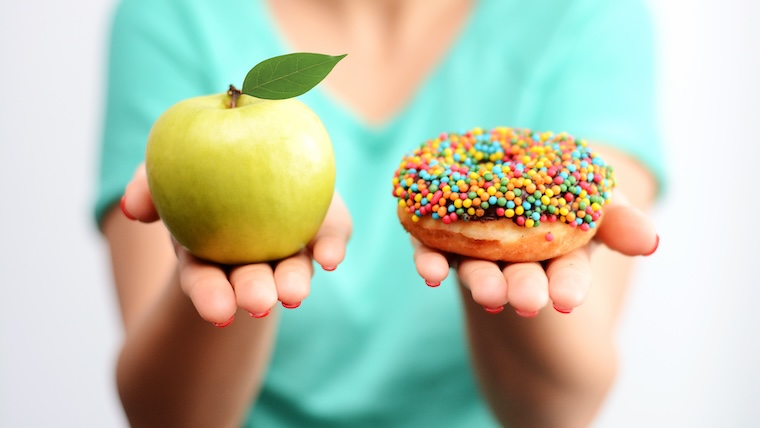In his March 1, 2024, YouTube series episode of “What The Fitness,” Dr. Layne Norton addresses Dr. Jason Fung’s, a doctor of nephrology best known as “the doctor who invented intermittent fasting,” stance on the calories in calories out (CICO) method for weight loss.
Norton counters Fung’s assertion of CICO’s ineffectiveness for weight loss by leveraging data from several human randomized controlled trials. Norton further addresses and debunks Fung’s claims regarding exercise, obesity, and insulin resistance.
Fung’s Weight Loss Claims
- CICO doesn’t work for weight loss
- Obesity is linked to genetics
- Exercise only has minimal effect on weight loss
- Insulin spikes negatively affect weight loss
Watch Norton dissect and refute Fung’s claims surrounding the CICO for weight loss below:
[Related: What To Eat Before a Workout: These Foods Will Help You Perform Better]
Calories In, Calories Out
Norton argues that Fung mistakenly conflates the energy balance model with calorie counting. Norton clarifies that while Fung asserts calorie restriction lowers metabolic rate, rendering such restriction ineffective for weight loss, the actual impact on metabolism is minimal, making calorie restriction a viable strategy for shedding pounds.
Furthermore, Norton highlights studies that show intermittent fasting — a method promoted by Fung — also leads to a similar decrease in metabolic rate, challenging the notion that it’s more effective than other diets. (1, 2, 3, 4, 5)
Obesity Due to Genetics
Norton concurs that having two obese parents raises the chances of obesity in their offspring. However, Norton cautions against Fung attributing this correlation to genetics alone. The influence of environmental factors is equally plausible, as children may adopt habits from their parents that contribute to obesity.

“You can make the same argument for environment if you have two parents who are obese and have habits that lead you to become more obese, such as more access to ultra-processed foods more senary those sorts of things,” says Norton. He added that children closely observe their parents from a young age and are inclined to mimic their behaviors as children are less influenced by verbal instructions and more by the actions they witness.
Effect of Exercise on Weight Loss
Norton contends that the impact of exercise on weight loss, as claimed by Fung to be minimal, varies significantly depending on the study. When adequately controlled, human randomized trials show significant responses based on the extent of exercise.
Norton emphasizes the critical role of exercise in weight maintenance, noting that 70 percent of individuals who successfully keep weight off continue to engage in physical activity.
The Role of Insulin
Norton challenges the notion that insulin impedes fat loss. He references human randomized controlled trials in Gastroenterology comparing diets with varied insulin levels (low fat and low carbs diets), that find when calorie intake is consistent and regulated, weight loss outcomes remain unchanged. (6)

Norton cites another trial in The American Journal of Clinical Nutrition, which demonstrated a notable increase in weight loss on a diet that elevates insulin levels by 47 percent. (7)
Personal Responsibility for Weight Loss
Norton posits that while critiqued by Fung, CICO also extends to intermittent fasting. According to Norton, the issue of obesity invariably involves an element of personal responsibility, but a lack of self-discipline is not entirely to blame.
Norton argues that labeling the calorie restriction model as blaming the individual while presenting intermittent fasting as devoid of such blame is misleading. Intermittent fasting advises reducing meal frequency and lowering refined carbohydrate intake. Viewed through this perspective, both weight loss approaches advocate similar principles.
References
- Rynders, C. A., Thomas, E. A., Zaman, A., Pan, Z., Catenacci, V. A., & Melanson, E. L. (2019). Effectiveness of Intermittent Fasting and Time-Restricted Feeding Compared to Continuous Energy Restriction for Weight Loss. Nutrients, 11(10), 2442. https://doi.org/10.3390/nu11102442
- Harris, L., Hamilton, S., Azevedo, L. B., Olajide, J., De Brún, C., Waller, G., Whittaker, V., Sharp, T., Lean, M., Hankey, C., & Ells, L. (2018). Intermittent fasting interventions for treatment of overweight and obesity in adults: a systematic review and meta-analysis. JBI database of systematic reviews and implementation reports, 16(2), 507–547. https://doi.org/10.11124/JBISRIR-2016-003248
- Welton, S., Minty, R., O’Driscoll, T., Willms, H., Poirier, D., Madden, S., & Kelly, L. (2020). Intermittent fasting and weight loss: Systematic review. Canadian family physician Medecin de famille canadien, 66(2), 117–125.
- Lowe, D. A., Wu, N., Rohdin-Bibby, L., Moore, A. H., Kelly, N., Liu, Y. E., Philip, E., Vittinghoff, E., Heymsfield, S. B., Olgin, J. E., Shepherd, J. A., & Weiss, E. J. (2020). Effects of Time-Restricted Eating on Weight Loss and Other Metabolic Parameters in Women and Men With Overweight and Obesity: The TREAT Randomized Clinical Trial. JAMA internal medicine, 180(11), 1491–1499. https://doi.org/10.1001/jamainternmed.2020.4153
- Stratton, M. T., Tinsley, G. M., Alesi, M. G., Hester, G. M., Olmos, A. A., Serafini, P. R., Modjeski, A. S., Mangine, G. T., King, K., Savage, S. N., Webb, A. T., & VanDusseldorp, T. A. (2020). Four Weeks of Time-Restricted Feeding Combined with Resistance Training Does Not Differentially Influence Measures of Body Composition, Muscle Performance, Resting Energy Expenditure, and Blood Biomarkers. Nutrients, 12(4), 1126. https://doi.org/10.3390/nu12041126
- Hall, K. D., & Guo, J. (2017). Obesity Energetics: Body Weight Regulation and the Effects of Diet Composition. Gastroenterology, 152(7), 1718–1727.e3. https://doi.org/10.1053/j.gastro.2017.01.052
- Hall, K. D., Chen, K. Y., Guo, J., Lam, Y. Y., Leibel, R. L., Mayer, L. E., Reitman, M. L., Rosenbaum, M., Smith, S. R., Walsh, B. T., & Ravussin, E. (2016). Energy expenditure and body composition changes after an isocaloric ketogenic diet in overweight and obese men. The American journal of clinical nutrition, 104(2), 324–333. https://doi.org/10.3945/ajcn.116.133561
Featured image via Shutterstock/Eviart